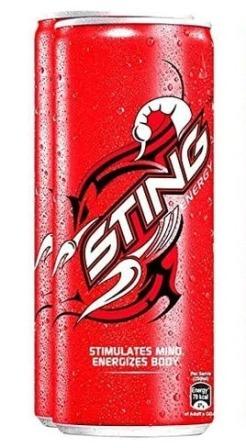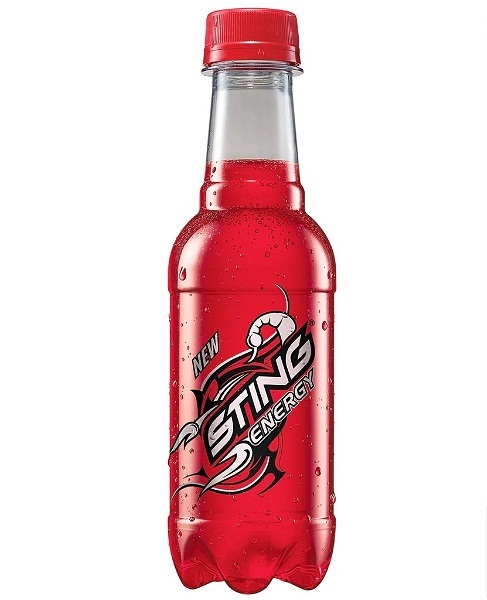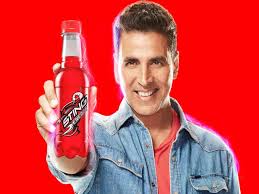Sting Energy Drink Ingredients: Sting Energy Drink (or Sting) company from PepsiCo International. Sting drink is an energy drink with an awesome refreshing taste and delicious flavour. Sting drink refreshes you and gives you an energy boost and also charges up to stay full of energy. Sting drink contains Caffeine, Ginseng, and Vitamin B with delicious flavour. It energizes the body. Read the full article to know more about Sting Energy Drink Ingredients in detail.
Sting Energy Drink Ingredients Details
The ingredients available in the Sting Energy Drink are Carbonated Water, Sugar, Acidity Regulators, maltodextrin, artificial flavor, potassium sorbate, sodium citrate, caffeine, sodium hexametaphosphate, sodium benzoate, inositol, sodium benzoate, modified food starch, pyridoxine hydrochloride, niacinamide, and cyanocobalamin. Let’s understand each ingredient in detail.
Sting Energy Drink Ingredients: Carbonated Water
Carbonated water is a type of water that contains dissolved carbon dioxide gas, also known as soda water, sparkling water, fizzy water, club soda, water with gas, mineral water (in many regions), or seltzer/seltzer water (especially in the United States). The carbonation process creates small bubbles, which gives it an effervescent quality. This can happen either through injection under pressure artificially or naturally through geological processes. There are a few different varieties of carbonated water, such as naturally sparkling mineral water, club soda, and commercially made sparkling water.
Certain varieties of carbonated water, such as club soda and mineral water, may contain supplementary minerals such as potassium bicarbonate, sodium bicarbonate, sodium citrate, or potassium sulfate that have been added or dissolved into them. Some mineral waters contain these naturally, but others are artificially added to manufactured waters to mimic a natural flavor and balance out the acidity caused by carbon dioxide gas.
Carbonated waters are available in bottles and cans, and can also be made on demand in bars and restaurants using commercial carbonation systems. You can also make them at home using a carbon dioxide cartridge. Both naturally occurring and artificially produced carbonated waters may contain trace amounts of several compounds, including sodium chloride, sodium citrate, sodium bicarbonate, potassium bicarbonate, potassium citrate, potassium sulfate, or disodium phosphate.
The specific additives present will vary depending on the source of the carbonation. Numerous products include minerals that are naturally present in mineral waters. However, in commercially produced waters, these minerals may be artificially added to mimic the natural taste and balance the acidity caused by the introduction of carbon dioxide gas, resulting in a low 5-6 pH carbonic acid solution.

Sting Energy Drink Ingredients: Sugar
Sugar is the term used to describe sweet-tasting, soluble carbohydrates that are widely used in food. This category includes monosaccharides, or simple sugars, such as glucose, fructose, and galactose. Compound sugars, also known as disaccharides or double sugars, are composed of two bonded monosaccharides.
Some common examples of these include sucrose (glucose + fructose), lactose (glucose + galactose), and maltose (two glucose molecules). Refined white sugar is a form of sucrose. When consumed, compound sugars are broken down into simpler sugars through the process of hydrolysis within the body. Sucrose is a common ingredient found in prepared foods such as cookies and cakes.
It is often added to commercially available processed food and beverages, and people also use it as a sweetener for foods like toast and cereal, as well as beverages like coffee and tea. On average, a person consumes approximately 24 kilograms (53 pounds) of sugar per year. However, individuals in North and South America consume up to 50 kg (110 lb) while those in Africa consume less than 20 kg (44 lb).
Read Also: Sting Energy Drink Advantages and Disadvantages.
Sting Energy Drink Ingredients: Artificial Flavour
A flavoring is a substance that changes the taste of another substance, making it sweet, sour, tangy, or altering its characteristics. In everyday language, the word refers to the blend of taste and scent that we experience when eating. However, in the fragrance and flavor industry, it is used to describe the chemicals and extracts that can alter the taste of food by affecting our sense of smell.
Chemically synthesized commercial flavorings are often used in place of natural extracts due to their high cost or limited availability. Flavorists can replicate the taste of natural foods, such as raspberries, by identifying and utilizing a select few of the same chemicals present.
The EU legislation provides specific definitions for “flavoring” and “natural flavoring,” but does not acknowledge “natural-identical flavoring.” Flavorings that are artificial are created by humans using chemical substances and are not naturally occurring. These flavorings usually have sensory qualities that resemble those of natural or nature-identical flavors.

Sting Energy Drink Ingredients: Maltodextrin
Maltodextrin is a type of polysaccharide that’s commonly used as a food ingredient. It’s made by partially hydrolyzing grain starch and typically comes in the form of a white, spray-dried powder that’s hygroscopic. Maltodextrin is easy for the body to digest, being absorbed just as quickly as glucose. Depending on the degree of polymerization, it can be either moderately sweet or almost tasteless. This ingredient can be found in many processed foods.
Maltodextrin is made up of chains of D-glucose units that come in varying lengths. These glucose units are connected primarily by α(1→4) glycosidic bonds, which are similar to the linear derivative of glycogen (minus the α1,6- branching). Maltodextrin is usually a mix of chains that range from three to 17 glucose units in length.
Maltodextrins are categorized based on their DE (dextrose equivalent) value, which ranges from 3 to 20. When the DE value is high, it means that the glucose chains are shorter, resulting in increased sweetness and improved solubility, while also decreasing heat resistance. If the DE value exceeds 20, it is referred to as glucose syrup according to the European Union’s CN code. On the other hand, maltodextrins with a DE value of 10 or less are classified as dextrins in the customs CN code nomenclature.
Sting Energy Drink Ingredients: Potassium Sorbate
Potassium sorbate is a white salt that is highly soluble in water (58.2% at 20 °C). Its chemical formula is CH3CH=CH−CH=CH−CO2K. This substance is mainly utilized as a food preservative (E number 202). Potassium sorbate is a highly valuable ingredient that can be conveniently found in a diverse range of products including food, wine, and personal-care items. Although rowan and hippophae berries contain sorbic acid, most of the world’s supply of this acid, which is essential for producing potassium sorbate, is artificially synthesized.
Potassium sorbate serves as a mold and yeast inhibitor in various food items like cheese, wine, yogurt, dehydrated fruits, apple cider, soft drinks, fruit drinks, and baked goods. It is also utilized in the production of hotcake syrup and milkshakes served by fast-food chains like McDonald’s. Potassium sorbate is commonly found in dried fruit products as a preservative.
This ingredient is effective in preventing mold and microbes, thereby extending the shelf life of herbal dietary supplements. Short-term use of safe quantities of potassium sorbate has not been associated with any negative health effects. Manufacturers should ensure that this information is clearly stated on their product labeling to inform consumers.
Manufacturers must make sure that their product labels clearly state information about the ingredients, such as “potassium sorbate” or “E202”, to inform consumers. This preservative is also added to personal-care products to prevent the growth of microorganisms and increase their shelf life. Some manufacturers are using it as an alternative to parabens.

Sting Energy Drink Ingredients: Caffeine
Are you aware that caffeine is a type of CNS stimulant that falls under the methylxanthine class? It is commonly used by people to improve their wakefulness and cognitive performance or for recreational purposes. So, how does it work? Caffeine obstructs the binding of adenosine to the adenosine A1 receptor, which in turn enhances the release of acetylcholine. This is possible because caffeine has a structure that is similar to adenosine, allowing it to bind and block the receptors. Furthermore, caffeine has the ability to increase cyclic AMP levels through nonselective inhibition of phosphodiesterase.
Caffeine is a natural compound that is bitter and appears as a white crystalline purine. This substance is a member of the methylxanthine alkaloid group and is chemically connected to the adenine and guanine bases found in DNA and RNA. This compound is found in various plants, including those that are indigenous to Africa, East Asia, and South America.
It acts as a protective mechanism for these plants by preventing the germination of neighboring seeds and discouraging herbivores from consuming them. However, it attracts certain animals such as honey bees. The coffee bean is the most well-known source of caffeine. People consume beverages containing caffeine to alleviate or prevent fatigue and improve their cognitive abilities. These drinks are made by steeping the plant product in water through a process called infusion to extract the caffeine.
It’s a fact that caffeine-containing beverages such as coffee, tea, and cola are widely consumed by people all over the world. With global coffee bean consumption reaching nearly 10 million tonnes in 2020, it’s clear that caffeine is the most commonly consumed psychoactive drug worldwide. What’s interesting about caffeine is that it’s legal almost everywhere and mostly unregulated, setting it apart from other drugs. Additionally, it’s socially acceptable in most cultures and even encouraged in some.
Caffeine can have both beneficial and adverse effects on an individual’s health. On the positive side, it can be used to treat and prevent premature infant breathing disorders such as bronchopulmonary dysplasia of prematurity and apnea of prematurity. It’s worth noting that caffeine citrate is listed as an essential medication on the WHO Model List. Additionally, some research suggests that caffeine may offer a small amount of protection against certain diseases, like Parkinson’s disease. Some individuals may experience sleep disturbances or anxiety after consuming caffeine, while others may not be affected.
The risk of consuming caffeine during pregnancy is uncertain, and some experts suggest that pregnant women should limit their caffeine intake to two cups of coffee per day or less. Regular consumption of caffeine can cause mild addiction that leads to withdrawal symptoms such as headaches, irritability, and sleepiness when one stops taking caffeine after repeated daily intake. Constant use of caffeine can cause tolerance to autonomic effects such as increased blood pressure, heart rate, and urine output, making these symptoms less noticeable or absent.
Sting Energy Drink Ingredients: Sodium Citrate
Sodium citrates serve as acidity regulators in food and beverages, as well as emulsifiers for oils. They allow cheeses to melt without getting greasy and also lessen the acidity of the food. Sodium citrate is a substance that helps prevent blood from clotting during storage.
In laboratories, it is used to assess whether a person’s blood is at risk of clotting or too thin to undergo surgery. Sodium citrate is also used in medical settings as an alkalinizing agent, replacing sodium bicarbonate to balance excess acid levels in the blood and urine.

Sting Energy Drink Ingredients: Sodium Hexametaphosphate
Sodium hexametaphosphate (SHMP) is a salt comprising Na6[(PO3)6] chemical formula. The commercial version of this salt contains a mixture of various metaphosphates, including the hexamer form, and is precisely known as sodium polymetaphosphate. These solid and white substances can readily dissolve in water.
SHMP is a versatile sequestrant that finds use across various industries. It is often employed as a food additive, with the E number E452i. To produce SHMP products for water softening and detergents, sodium carbonate is added to raise the pH to 8.0-8.6. Sodium hexametaphosphate is a highly effective deflocculant that is widely utilized in the manufacturing process of clay-based ceramic particles.
Additionally, it functions as an exceptional dispersing agent that can break down clay and other soil types, allowing for a thorough evaluation of their texture.
Sting Energy Drink Ingredients: Sodium Benzoate
Sodium benzoate is a food preservative and pickling agent, commonly used in the food industry. It is the sodium salt of benzoic acid and has an E number of E211. The chemical that is being referred to is a white crystalline substance with the formula C6H5COONa.
Sodium benzoate is a food preservative that is commonly used in acidic foods like salad dressings (which contain acetic acid from vinegar), carbonated beverages (which contain carbonic acid), jams, and fruit juices (which contain citric acid), pickles (which contain acetic acid), condiments, and frozen yogurt toppings.
In addition, it is utilized as a preservative in medicines and cosmetics. When subjected to specific conditions, a substance referred to as E210 transforms into benzoic acid. This substance possesses the ability to inhibit the growth of bacteria and fungi. However, due to its low solubility in water, benzoic acid is not typically used in its pure form. Furthermore, the FDA has limited its concentration to 0.1% by weight when used as a food preservative in the United States.
Sodium benzoate, an animal food additive, has been approved by the Association of American Feed Control Officials with a maximum allowance of 0.1%. In the United Kingdom, most soft drinks have been replaced with potassium sorbate instead of sodium benzoate. During the 19th century, Harvey W. Wiley investigated the use of sodium benzoate as a food ingredient with his ‘Poison Squad’ under the US Department of Agriculture. This investigation resulted in the creation of the Pure Food and Drug Act in 1906, which is a significant event in the early history of food regulation in the United States.


Pingback: Sting Energy Drink Nutritional Information - Stingdrink.com
Pingback: How Many Calories in Sting 250ml - Stingdrink.com